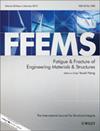Unraveling the Effect of Retained Austenite on the Very High Cycle Fatigue Crack Initiation Mechanism of Carbide-Free Bainitic Steel
Abstract
The very high cycle fatigue behaviors of a carbide-free bainitic steel were investigated to unravel the mechanisms of two types of non-inclusion induced crack initiation characteristic areas with different morphologies and to explore the role of retained austenite. Results show that in preferentially oriented conditions, the dislocation slips are difficult to activate in the inter-lath nanometer-sized retained austenite. Consequently, the fatigue crack initiates from coarse bainitic ferrite lath with preferred orientation and high Schmid factor, resulting in the formation of inclined micro-facet within the crack initiation characteristic area, which is dominated by mode II cracking. However, for the submicron-sized retained austenite and the non-preferentially orientated bainitic ferrite, dislocation slips preferentially occur along their phase interfaces and impinge into the prior austenite grain boundaries, resulting in the generation of extrusions at grain boundaries and the final intergranular crack initiation. In this situation, the formation of micro-facet still takes place but may be controlled by mode I cracking. These findings provide new insights into the relationship between microstructural features and cyclic loading that could lead to different mechanisms of non-inclusion induced crack initiation.

 求助内容:
求助内容: 应助结果提醒方式:
应助结果提醒方式:


